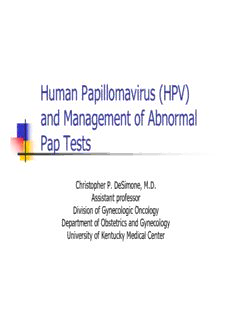
HPV and Abnormal PAP Tests PDF
Preview HPV and Abnormal PAP Tests
Human Papillomavirus (HPV) and Management of Abnormal Pap Tests Christopher P. DeSimone, M.D. Assistant professor Division of Gynecologic Oncology Department of Obstetrics and Gynecology University of Kentucky Medical Center The Papanicolaou Test Developed by Dr’s. Papanicolaou and Traut in the 1940’s Consists of collecting cervical cytology from the cervix and depositing them onto a slide for microscopic evaluation Easy to collect and objectively interpret results Initially used to detect cervical cancer Papanicolaou and Traut: Diagnosis of uterine cancer by the vaginal smear, 1943 The Papanicolaou Test The pap has dramatically decreased the the incidence and mortality rate of cervical cancer in the United States U.S. 10,000 new cases each year 3700 deaths annually from cervical cancer Worldwide 493,000 new cases 293,000 deaths annually worldwide Parkin et al. Int J Cancer, 2005. The Papanicolaou Test Estimated 50 million paps performed in the U.S. 5% will be diagnosed as abnormal ASCUS 2-3 million ASC-US paps LGSIL 1 million LSIL paps HGSIL Cancer 600,000 HSIL paps Economics behind these numbers are staggering Who Develops Cervical Cancer? 50% of women diagnosed with cervical cancer have not had a pap test in 5 years 25% of all cervical cancers are diagnosed in women older than 65 In women older than 65, it is estimated that over 50% have not had a pap test in the past 10 years Bottom Line – the majority of women with cervical cancer fail to get annual pap tests Overview American Cancer Society guidelines for Pap testing Bethesda 2001 Pap nomenclature Human papillomavirus (HPV) Types of HPV Incidence of HPV Incidence of HPV in cervical cancer and preinvasive disease Mechanism for oncogenesis Associated risk of cervical cancer with smoking Management of abnormal Pap tests Types of treatment Screening intervals after treatment HPV vaccines American Cancer Society screening guidelines for Pap testing Begin testing 3 years after starting vaginal intercourse or no later than 21 Interval is every year for a conventional pap test or every other year with liquid cytology Saslow et al. Cancer J Clin, 2002. American Cancer Society screening guidelines for Pap testing At 30 years of age: IF > 3 normal/negative, satisfactory, consecutive pap tests then every 3 years IF no high-risk factors High-risk factors include: any abnormal pap tests, HPV infections, other STD’s – syphilis, HIV, gonorrhea and chlamydia Saslow et al. Cancer J Clin, 2002. American Cancer Society screening guidelines for Pap testing Cease screening IN Women > 70 with normal pap tests in the past 10 years Women status post total hysterectomy for non-neoplastic diseases Saslow et al. Cancer J Clin, 2002 Abnormal Pap Smears (Old Bethesda Nomenclature) HPV (Human HGSIL (High Grade Papilloma Virus) Squamous Intraepithelial Lesion) LGSIL (Low Grade Squamous AGUS (Atypical Glandular Cells of Intraepithelial Unknown Significance) Lesion) AIS (Adenocarcinoma ASCUS (Atypical In Situ) Squamous Cells of CIS or Carcinoma Unknown Significance)
Description: